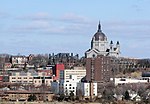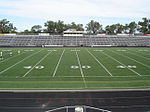Minnesota Governor's Residence

The Minnesota Governor's Residence, informally referred to as the Governor's Mansion, serves as the official home of the governor of the U.S. state of Minnesota. The house, located at 1006 Summit Avenue in Saint Paul, is on 1.5 acres (0.61 ha) of land. The building is slightly more than 16,000 square feet (1,500 m2) in size.The house was designed by Minneapolis architect William Channing Whitney for Saint Paul lumber businessman Horace Hills Irvine and his family. The 20 room English Tudor house has nine bedrooms, eight bathrooms, and nine fireplaces. The Irvine family lived in the home from 1912 until 1965, when the Irvines' youngest daughters, Clotilde Irvine Moles and Olivia Irvine Dodge, donated it to the people of Minnesota to serve as the official residence of the First Family. The Minnesota Legislature in 1965 passed a law accepting the donation and designating the house as the State Ceremonial Building for official public use for state ceremonial functions and as a governor's residence. The law placed the house and its management under the jurisdiction of the Minnesota Department of Administration. From 1965 until 1980, governors were permitted to propose changes to the house. The Legislature provided renovation funds and the Department of Administration supervised the improvements. From 1965 to 1967, a committee assisted with furnishing the house, but the governor retained the authority to make changes. In 1974, the house was listed on the National Register of Historic Places. With this designation, any renovation to the exterior of the residence must be reviewed and approved by the State Historic Preservation Office of the Minnesota Historical Society. It is also a contributing property to the Historic Hill District.Every year, a forester from the Minnesota Department of Natural Resources selects a giant Christmas tree, harvested from a Minnesota State Forest, often from near Pine City, to adorn the front lawn during the holiday season.
Excerpt from the Wikipedia article Minnesota Governor's Residence (License: CC BY-SA 3.0, Authors, Images).Minnesota Governor's Residence
Summit Avenue, Saint Paul Summit Hill
Geographical coordinates (GPS) Address External links Nearby Places Show on map
Geographical coordinates (GPS)
| Latitude | Longitude |
|---|---|
| N 44.941027777778 ° | E -93.142916666667 ° |
Address
Minnesota Governor's Residence
Summit Avenue
55105 Saint Paul, Summit Hill
Minnesota, United States
Open on Google Maps







